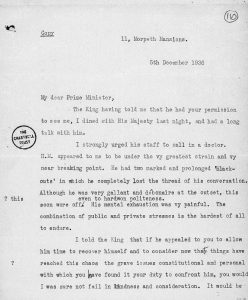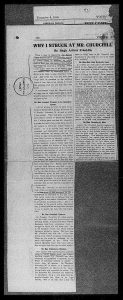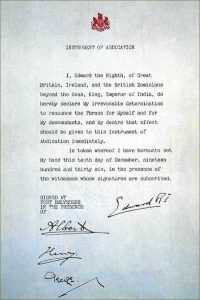
Finest Hour 177
Winston Is Back!
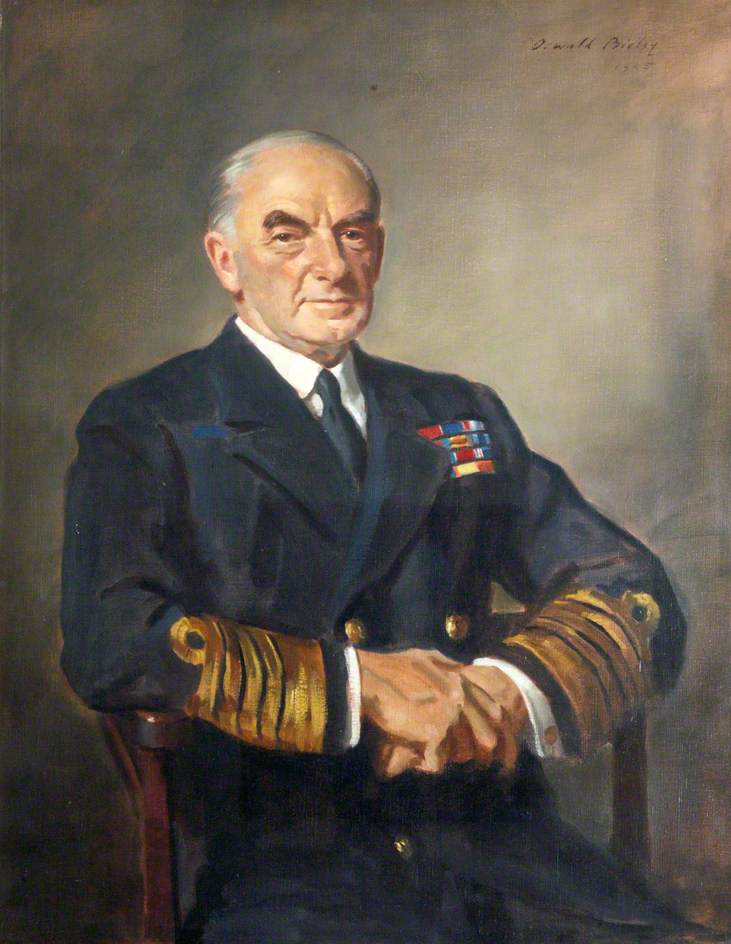
Admiral of the Fleet Sir Dudley Pound
October 5, 2017
Finest Hour 177, Summer 2017
Page 32
By Eric Grove
After announcing the declaration of war on 3 September 1939, Prime Minister Neville Chamberlain appointed Winston Churchill First Lord of the Admiralty. This had been the position held by Churchill when the First World War began a quarter of a century earlier. In 1914 Churchill took a typically proactive role, drafting signals and having a problematical relationship with his First Sea Lord, the professional head of the Royal Navy, Lord Fisher. This culminated in a very public clash over the Dardanelles campaign in 1915 and marked a major reverse in Churchill’s career.
As Chancellor of the Exchequer in the 1920s, Churchill fought a campaign against the Admiralty’s shipbuilding plans. He seemed much more interested in the Royal Air Force than the Royal Navy when he adopted rearmament as a cause in the 1930s. Only late in the decade did Lord Chatfield, the First Sea Lord masterminding naval rearmament, mobilise Churchill to the navy’s cause by granting him access to secrets and obtaining his support for a successful campaign to bring the Fleet Air Arm under full naval control. Given this somewhat chequered record, the signal “Winston is back!”—often believed but not proven to have been sent out to the fleet in 1939— would have been as much a warning to senior officers as a morale booster for the younger generation.
A Privilege and Honour
Churchill was visibly moved by his return to the Admiralty. Third Sea Lord Bruce Fraser remembered: “As he took the First Lord’s chair in the famous Board Room, Churchill was filled with emotion. To a few words of welcome from the First Sea Lord [Sir Dudley Pound], he replied by saying what a privilege and honour it was to be again in that chair, that there were many difficulties together we would overcome. He surveyed critically each of us in turn and then, adding he would see us all later on, he adjourned the meeting, ‘Gentlemen,’ he said, ‘to your tasks and duties.’”1
Churchill certainly introduced much greater dynamism into the higher direction of the Royal Navy. Captain G. R. G. Allen, Deputy Director of the Trade Division of the Naval Staff, remembered: “One thing [that] remains firmly in my mind about Winston’s arrival at the Admiralty was the immediate impact he made on the Staff at all levels, both service and civilian. From the very first day, even I in my subordinate situation became aware of this presence, and I among others began to receive little notes signed by W. S. C. from the private office demanding reports of progress direct to him. If the required report was a good one (and it would not necessarily be one’s fault if it were not) one might get a reply in red ink—‘vg press on.’ It was like the stone thrown into the pond, the ripples go out in all directions, galvanizing peoples at all levels to ‘press on’—and they did.’”2

2025 International Churchill Conference
Churchill’s enthusiasm sometimes got the better of him, and many officers resented his interference with what they regarded as professional matters. The First Lord’s relationship with Admiral Pound was crucial. This has been a matter of some controversy among historians. Pound suited Churchill. The First Sea Lord was himself a great centralizer and prone to “back seat driving” of operations. Certainly the First Lord’s instincts to micromanage the navy’s activities fitted in with Pound’s own command style. Professor Chris Bell, always scrupulously fair, puts it thus: “It is virtually impossible now to determine which signals originated with Pound, which with Churchill, and which were genuinely joint efforts.”3 It is significant, nevertheless, that Pound’s generally supportive biographer concluded that “Churchill was allowed to intervene in operations far more than Pound should have been prepared to accept.”4
Baltic Leanings
There was only one major disagreement where Pound managed to curb the First Lord. This was Operation Catherine, the plan to send a powerful fleet of surface units based around strengthened “R” class battleships into the Baltic to interrupt German communications with Sweden. In its basics, this was a good idea, as it was known how much Germany—without enough steel for its war making purposes—depended on Swedish supplies. Asserting sea control in the Baltic might well have been a winning strategy—if it had been practical. Baltic operations had been considered in the First World War but had never been attempted except by submarines, mainly because of the failure to destroy the High Seas Fleet. In 1939, Germany was much weaker in surface forces, but the underwater threat from U-boats and mines combined with the air threat from operating so close to Luftwaffe bases was prohibitive.
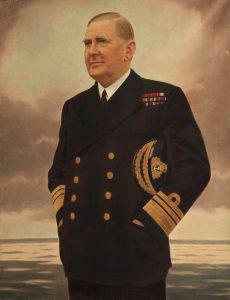
Churchill put the recently retired admiral William Boyle, by then the Earl of Cork and Orrery, in charge of a planning committee. Boyle was optimistic, but Pound and the Naval Staff were unwilling to take potentially useful capital ships out of service for conversion as long as there was a possibility of Italy or Japan widening the war. In December, Pound recommended that Boyle’s committee be disbanded. Churchill refused. In doing so, he made several strategic points: “The entry into the Baltic…would soon bring the raiders home and give us measureless relief. If we allow ourselves indefinitely to be confined to an absolute defensive by far weaker forces, we shall simply be worried and worn down while making huge demands upon the national resources. I could never be responsible for a naval strategy which excluded the offensive principle and relegated us to keeping open the lines of communication and maintaining the blockade.”5
Churchill broadened the Boyle Committee’s remit to examine all potentially offensive schemes. Operation Catherine, however, was effectively abandoned on 23 January 1940. Captain V. H. Danckwerts, the able Director of Plans of the Naval Staff, became the main casualty. Having argued cogently against the Baltic offensive, he was sacrificed to the First Lord’s enthusiasm. A rather guilty Pound arranged for Dankwerts to obtain a good command, the aircraft carrier Furious.
That Sinking Feeling
The Royal Navy had a mixed record under the leadership of Churchill and Pound. Churchill preferred the hunter-killer approach to counter the U-boat threat to the tried system of defended convoys, but he did not stop a limited convoy system from being set up after the sinking of the liner Athenia seemed to show that the Germans had begun a new campaign of unrestricted submarine warfare. Attempts to cover independent ships by patrols launched from aircraft carriers led to disaster when HMS Courageous was torpedoed and sunk and Ark Royal just escaped the same fate. The carrier patrols ceased, but Churchill remained enthusiastic about “offensive” destroyer operations, which he compared not very aptly to the cavalry. Like many at the Admiralty at the time, Churchill overestimated the effectiveness of sonar, with which the Admiralty has impressed Churchill before the war.
In October 1939, U-47 penetrated the inadequate defences of Scapa Flow and sank the battleship Royal Oak, the most heavily modernised ship in its class. Churchill was big enough to pay tribute to the skill and daring of the German captain, but the loss caused a crisis over where to base the Home Fleet. It was first withdrawn to Loch Ewe on the northwest coast of Scotland, as it had been at a similar stage of the First World War. Then flagship HMS Nelson was mined off the new base, and Churchill and Pound ordered the Commander in Chief, Admiral Sir Charles Forbes, to move further south to the Clyde. Quite rightly Forbes opposed this, as it would prevent him putting a stopper in the Atlantic entry points. Churchill and Pound went up to Scotland to force Forbes to comply, but the admiral stood firm and convinced the First Lord of his view. The defences of Scapa Flow were improved [see FH 171, “The Churchill Barriers”], and the fleet duly returned there in March 1940. Forbes had won the argument, but he may well have made a long-term enemy; Churchill rarely took to officers who stood up to him publicly. Forbes was eventually relieved of his command early.
The Battle of the River Plate
The greatest success of Churchill’s second time at the Admiralty was the victory over the German “pocket battleship” Admiral Graf Spee off the River Plate by Commodore Henry Harwood’s three cruisers Ajax, Exeter, and Achilles. Harwood was immediately promoted to Rear Admiral and became something of a Churchill favourite. As soon as the action was reported, Churchill got out of bed and went to the Admiralty’s Operational Intelligence Centre. As Admiral John Godfrey remembered, “The First Lord clad in his strange night garment and wondering what would happen next, was itching to emit a series of instructions to Bobby Harwood and would have done so but for the presence of Admiral Pound, who in his quiet way, was able to convince him that Harwood knew what he was about.”6
When the damaged Exeter returned to Britain, the Admiralty made sure it had a strong escort. Churchill welcomed her in person at Devonport and made a speech to the ship’s company in typical terms: “This great action will long be told in song and story. When you came up the river this morning, when you entered the harbour and saw the crowds cheering on the banks, one might almost think that there were other spectators in the great shades of the past, carrying us back to the great days of Drake and Raleigh, to the great sea dogs of olden times. If their spirits brooded on this scene, you would be able to say to them, ‘We, your descendants, still make war and have not forgotten the lessons you taught.’”7
Nordic Enterprise
Churchill was already heavily involved in new offensive plans. Stopping the flow of Swedish iron ore remained the target. As early as 19 September 1939, Churchill had proposed to the War Cabinet a plan to deny Germany maritime access to the Norwegian port of Narvik, the only conduit through which the ore could be exported during the winter months.
Again it is hard to fault Churchill’s strategic logic, informed as it was by the reports of the Ministry of Economic Warfare on Germany’s heavy dependence on this raw material. Churchill put it well in December: “No other measure is open to us for many months to come which gives so good a chance of abridging the waste and destruction of the conflict, or of perhaps preventing the vast slaughters which will attend the grapple of the great armies….If Germany can be cut off from all Swedish ore supplies from now onwards till the end of 1940, a blow will have been struck at her war-making capacity equal to a first-class victory in the field or from the air, and without any serious sacrifice of life. It might, indeed, be immediately decisive.”8
This was in support of a plan to mine Norwegian coastal waters, a submarine mine laying mission off Lulea (the Swedish side of the railway from the ore fields), and, if the Germans retaliated, occupying Narvik and Bergen. Churchill argued that small nations should not tie the hands of great powers fighting for their rights and freedoms. The Soviet invasion of Finland had opened up other opportunities, and on 20 December Churchill argued for an expedition to aid the Finns and capturing the northern iron ore fields in the process. Two days after that, Churchill was arguing for destroyer operations in Norwegian territorial waters to stop coastal traffic and an advance to occupy the ore fields if the Germans landed in Sweden. By 27 December, Churchill had returned to naval action by destroyers alone. But now, perhaps ironically, the Chiefs of Staff argued for a land attack on the ore fields via Narvik. The First Lord’s was no longer the most aggressive voice in decision-making circles. Most favoured Churchill’s more moderate scheme, but Norway’s reaction to the proposal was very hostile. Churchill argued for going ahead anyway, wanting to make the Scandinavians more scared of the Allies than the Germans!
Altering Course
The next incident to affect Norway was the situation created when the Altmark, auxiliary of the Admiral Graf Spee, tried to exploit Norwegian neutrality to return to Germany with prisoners taken from the ships sunk by the now-destroyed Spee. Churchill played a leading role in what followed by obtaining the approval of the Foreign Secretary, Lord Halifax, over the telephone to signal Captain Philip Vian in the destroyer Cossack to violate Norwegian neutrality to rescue the prisoners. At one level, this was an example of effective action, but at another it was unwise to bypass Admiral Forbes, under whose command Vian was operating. In the end, there was no conflict of orders, and all ended well with a minor triumph made famous by the cry “The Navy’s here!” as the merchant sailors were liberated.
This incident led Churchill to resume his campaign for a mining operation. This became Operation Wilfred coupled with R4, the deployment of British forces in Norway if Germany reacted. Unfortunately, it also encouraged Hitler to carry out a pre-emptive strike to safeguard his vital supplies. The Germans won the race for Norway. It did not help that Churchill and Pound had ordered the ships carrying the R4 forces to disembark their troops so that the ships could join the Home fleet opposing a suspected breakout in the Atlantic. The Norwegian campaign ended as a dreadful failure for British sea power. As Arthur Marder, a pro-Churchill historian, put it, “there can be no dispute about Churchill’s strong influence on the inept overall strategy of the campaign, including the changes of plan as well as upon the combined operations.”9
This was especially so as Churchill had taken over the chair of the Cabinet’s Military Coordination Committee, having manoeuvered the former Admiral Chatfield, the Minister for the Coordination of Defence, out of office. The ultimate irony of this, of course, was that it was Norway that caused the fall of the Chamberlain Government and Churchill’s elevation to Prime Minister and Minister of Defence. Never has failure been crowned with more success.
Eric Grove is an independent British naval historian, author, and maritime strategist.
Endnotes
1. Arthur J. Marder, From the Dardanelles to Oran (Annapolis, MD: Naval Institute Press, 2015), p. 106.
2. Ibid., p. 107.
3. Christopher M. Bell, Churchill and Sea Power (Oxford: Oxford University Press, 2013), p. 193.
4. Robin Brodhurst, Churchill’s Anchor (London: Leo Cooper, 2000), p. 139.
5. Ibid., p. 171.
6. Marder, p. 138, note 66.
7. Robert Rhodes James, ed., Winston S. Churchill: His Complete Speeches, 8 vols., vol. VI, 1935–1942 (London: Chelsea House, 1974), p. 6192.
8. Martin Gilbert, ed., The Churchill War Papers, vol. 1, At the Admiralty, September 1939–May 1940 (New York: Norton, 1993), pp. 522–23.
9. Marder, p. 166.
Subscribe
WANT MORE?
Get the Churchill Bulletin delivered to your inbox once a month.

